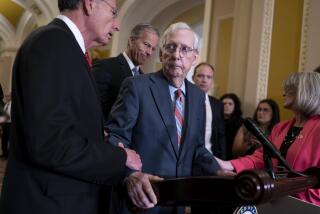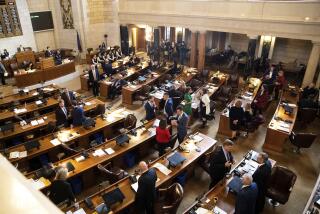Long-Winded Senate Tradition
WASHINGTON — Thanks to the ever-popular “Mr. Smith Goes to Washington,” most Americans have one enduring image of the U.S. Senate: a place where even rookie lawmakers can filibuster a bill to death by talking for hours, days -- or as long as their legs can hold up.
However, that 1939 movie image is as relevant to today’s Senate as the LP is to modern music recording.
The filibuster -- the storied Senate tradition of blocking a bill by talking around the clock -- is hardly ever conducted the old-fashioned way.
Beginning this evening, Senate Republicans plan to invoke the spirit of that tradition by forcing Democrats to talk through the night to sustain their filibuster of several controversial judicial nominations.
But no one expects the staged 30-hour talkathon to break the yearlong deadlock over judges, and Republicans admit the event is more a public relations effort to spotlight an obscure issue than a realistic drive to break the opposition.
The fanfare that has gone into holding the Senate in an all-night session, the outcome of which is preordained, underscores just how marginal the old-style filibuster has become.
Long gone are the days when the filibuster was deployed mostly for issues of great national significance such as civil rights and war, with senators holding the floor by reciting recipes, reading from the Bible and devising ways to avoid trips to the bathroom.
Such spectacles have become a rarity in part because of the growth of federal social programs since President Johnson’s Great Society of the mid-1960s. With more and more legislation demanding their attention, congressional leaders have been less willing to let the Senate get tied up on a single issue.
That is one reason Senate leaders devised a technique in the mid-1970s for keeping filibusters from bringing the work of the chamber to a halt: When someone threatens a filibuster, leaders simply move on to other business. The result has been fewer full-blown filibusters but more filibuster threats: Senators freely warn they will filibuster a bill, safe in the assumption that leaders will not force them to pull an all-nighter.
Some analysts say the demise of the genuine filibuster also reflects a broader decline in the quality of Senate debate in an era of sound-bite politics.
“The sound bite is the enemy of sustained argument,” said Ross Baker, a political scientist at Rutgers University. “I don’t think the kind of oratorical cut and thrust that used to be so characteristic of the Senate occurs anymore.”
The filibuster -- a term rooted in a Dutch word for “freebooter,” or pirate -- is distinctive to the Senate. The Senate’s rules, unlike the House’s, allow most debates to proceed without time limits. A single senator can block a vote by talking and refusing to give up the floor. It is a power senators proudly see as part of their constitutional role as the more deliberative half of Congress, where minority voices can be heard.
“That really is what the U.S. Senate is all about,” said Donald A. Ritchie, associate historian of the Senate. “A single voice can stop the proceedings and force everyone else to pay attention.”
Through most of the 19th century, no mechanism was in place for cutting off a filibuster. That changed in 1917, after a filibuster blocked a bill to allow merchant ships to be armed against German submarine attacks during World War I. Infuriated, President Wilson called the Senate back into session to pass the bill and adopt new procedures for cutting off filibusters.
The rule called for closing debate -- or invoking “cloture” -- by a vote of two-thirds of the senators present. That threshold was lowered to 60 votes in 1975 and remains today. That is why, in practice, it takes the support of 60 senators -- not just a simple majority of 51-- to pass legislation in the Senate.
The great filibusters of the 20th century are the stuff of Senate legend. Many filibusters have been conducted by teams of like-minded senators. But on rare occasions, a senator has gone solo.
Sen. Huey P. Long of Louisiana unleashed his longest and most dramatic torrent of words in 1935 in support of a provision to require Senate confirmation of certain administration appointees. Speaking for 15 hours and 30 minutes, according to the Senate Historical Office, Long quoted the Bible, read the entire U.S. Constitution, offered a recipe for pot liquor and gave a lengthy description of how to cook oysters.
A solo filibuster is a challenge because the senator is not able to leave even to use the bathroom without risking losing control of the floor. While Sen. Estes Kefauver (D-Tenn.) conducted a filibuster in 1950, he added to his staying power by rigging up a urine bag in his pants. When the tube came undone, the presiding officer let Kefauver leave to fix the problem, Ritchie said.
Sen. Strom Thurmond (D-S.C.) held the record for a solo filibuster, talking for 24 hours and 18 minutes against the Civil Rights Act of 1957. Unlike others who filled time with irrelevant disquisitions, Thurmond spent the entire time discussing the bill and related issues.
The longest filibuster was an 87-day fight against the 1964 Civil Rights Act, a turning point in the nation’s long struggle over outlawing racial discrimination. It marked the first time the Senate had been able to cut off the filibuster of a civil-rights bill.
Senate Republican leader Everett M. Dirksen of Illinois closed debate by paraphrasing French writer Victor Hugo: “Stronger than all the armies is an idea whose time has come. The time has come for equality of opportunity in sharing in government, in education and in employment. It will not be stayed or denied. It is here!”
The filibuster lost much of its power in the 1970s. Senate Majority Leader Mike Mansfield, a Montana Democrat, devised the strategy of handling legislation on a dual track, so the Senate could continue with other business until a compromise was reached on a disputed bill.
“That led to the complete atrophying of the old-style filibuster,” said Norman Ornstein, an expert on Congress at the American Enterprise Institute.
“Senators don’t like to spend much time on the floor,” said Baker, the Rutgers political scientist. “They would much rather be fund-raising, back in their offices or in committee meetings.”
While that meant genuine filibusters were fewer, there was an explosion of filibuster threats precisely because senators did not expect to have to hold the floor. Senate leaders began calling for votes to cut off debate even before it began.
The result: In 2001 and 2002, the Senate held 58 votes to cut off debate, more than were held from 1919 to 1969. Most were to block filibusters that never began.
Even as the filibuster became rarer, the tactic came to be used for a wider range of issues. Liberals who had once shunned the tactic now embraced it, using it to challenge a 1977 bill to deregulate natural gas.
The filibuster was also deployed in service of parochial interests. In 1992, the last time the Senate stayed in session all night for a filibuster, Sen. Alfonse M. D’Amato (R-N.Y.) was fighting for a tax provision to save 875 jobs at a typewriter factory in his home state.
Senators have been brushing up on the tricks of the filibuster trade in preparation for this week’s 30-hour debate on judges. Sen. Harry Reid (D-Nev.) spoke on the Senate floor for 8 1/2 hours Monday to protest Republicans’ spending so much time on four disputed judges instead of on joblessness. Reid read six chapters from a book he wrote about his tiny hometown of Searchlight, Nev.
But this week’s round-the-clock debate does not amount to a true filibuster. Instead, the Republican majority is setting a debate with distinct time limits, in hopes of spurring Senate action, rather than blocking it.
Republicans say the spectacle is designed more to send a message outside the Senate -- where conservative Republican activists complain that GOP leaders have not done enough to break Democrats’ filibusters -- than to change votes inside the Senate.
“A lot of people think we should be doing more,” said Sen. Rick Santorum (R-Pa.). “So we’re doing more.”
*
(Begin Text of Infobox)
Holding the floor / All-night Senate sessions since 1915:
* 1915 -- Ship Purchase Act: Feb. 8-10 (54 hours, 10 minutes).
* 1927 -- Resolution to continue investigation of election cases: March 2-4 (37 hours, 2 minutes).
* 1935 -- National Recovery Act extension: June 12-13 (18 hours, 20 minutes).
* 1947 -- Veto of labor bill: June 20-21 (30 hours, 52 minutes).
* 1948 -- Closing session: June 18-20 (44 hours, 14 minutes).
* 1950 -- Closing session: Sept. 22-23 (29 hours, 53 minutes). Sen. William Langer (R-N.D.) collapsed during a filibuster on the veto of a Communist registration bill.
* 1952 -- Supplemental appropriations for fiscal year 1953: July 5-6 (17 hours, 9 minutes).
* 1953 -- Tidelands oil bill: April 24-25 (23 hours, 50 minutes).
* 1957 -- Civil rights debate: Aug. 28-30 (38 hours, 59 minutes). Sen. Strom Thurmond (D-S.C.) spoke from 8:54 p.m. Aug. 28 until 9:12 p.m. the next day, breaking the record for longest Senate speech.
* 1960 -- Civil rights: Feb. 29 to March 5 (125 hours, 16 minutes). The longest unbroken session during that period took 82 hours and 2 minutes.
* 1960 -- Sugar Act: July 2-3 (22 hours, 33 minutes).
* 1961 -- Nomination of Lawrence J. O’Connor Jr. of Texas to the Federal Power Commission: Aug. 8-9 (31 hours, 59 minutes).
* 1964 -- Civil rights debate: June 9-10 (23 hours, 51 minutes). Sen. Robert C. Byrd (D-W.Va.) began at 7:38 p.m. and spoke for 14 hours and 13 minutes.
* 1977 -- Natural Gas Policy Act: Sept. 27-28 (22 hours, 12 minutes).
* 1978 -- Closing session: Oct. 14-15 (34 hours, 16 minutes).
* 1980 -- Selective Service: June 20-21 (32 hours, 43 minutes).
* 1981 -- Debt limit: Sept. 28-29 (23 hours, 26 minutes).
* 1981 -- Continuing appropriations for fiscal year 1982: Nov. 19-20 (20 hours, 50 minutes).
* 1982 -- Continuing appropriations for fiscal year 1983: Dec. 16-17 (37 hours, 51 minutes).
* 1984 -- Continuing appropriations for fiscal year 1985: Oct. 3-4 (22 hours, 32 minutes).
* 1986 -- Public debt limit increase: Aug. 15-16 (18 hours, 33 minutes).
* 1986 -- Veto of South African sanction and continuing resolution: Oct. 2-3 (20 hours, 57 minutes).
* 1988 -- Senate Election Campaign Act: Feb. 23-25 (57 hours, 24 minutes).
* 1992 -- Tax bill: Oct. 5-6 (33 hours, 35 minutes). Sen. Alfonse M. D’Amato (R-N.Y.) spoke for 15 hours and 14 minutes in support of an amendment to the bill.
*
Sources: Senate Historical Office, Associated Press
Los Angeles Times
More to Read
Get the L.A. Times Politics newsletter
Deeply reported insights into legislation, politics and policy from Sacramento, Washington and beyond. In your inbox three times per week.
You may occasionally receive promotional content from the Los Angeles Times.











